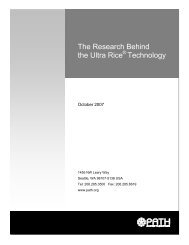Nepal Clean Home Delivery Kit: Evaluation of the Health Impact - Path
Nepal Clean Home Delivery Kit: Evaluation of the Health Impact - Path
Nepal Clean Home Delivery Kit: Evaluation of the Health Impact - Path
Create successful ePaper yourself
Turn your PDF publications into a flip-book with our unique Google optimized e-Paper software.
Intermediate Outcomes<br />
Important intermediate outcomes potentially associated with use <strong>of</strong> clean home delivery<br />
kits include behaviors, knowledge, and intentions that might reasonably be expected to be<br />
related to longer-term improvements in health or to health impacts that cannot be detected<br />
in smaller surveys. These would include indicators <strong>of</strong> behavior change such as <strong>the</strong> birth<br />
attendant washing her hands before <strong>the</strong> delivery and <strong>the</strong> cord cutting, correct use <strong>of</strong> <strong>the</strong><br />
items in <strong>the</strong> kit, and safe reuse or disposal <strong>of</strong> kit items after <strong>the</strong> delivery. Changes in<br />
knowledge related to <strong>the</strong> pictorial insert would be indicated by understanding <strong>of</strong> one or<br />
more <strong>of</strong> <strong>the</strong> eight messages in <strong>the</strong> insert (not just <strong>the</strong> practices but <strong>the</strong> concepts <strong>of</strong> three<br />
cleans). Client intention to use <strong>the</strong> kit herself in future deliveries and/or to recommend it<br />
to o<strong>the</strong>rs would be an indicator <strong>of</strong> an enhanced perception <strong>of</strong> <strong>the</strong> importance <strong>of</strong> a hygienic<br />
delivery, as well as <strong>the</strong> likely continued purchase <strong>of</strong> <strong>the</strong> kit.<br />
Factors Potentially Related to <strong>the</strong> Use or <strong>the</strong> Effectiveness <strong>of</strong> <strong>the</strong> <strong>Kit</strong><br />
Factors that help characterize <strong>the</strong> study populations and that might be related to <strong>the</strong> use <strong>of</strong><br />
kits or to <strong>the</strong> health outcomes <strong>of</strong> interest include: sociodemographic factors (like age,<br />
education, religion, economic status); health history factors (like parity, previous perinatal<br />
deaths, use <strong>of</strong> antenatal care, prior tetanus toxoid); and events associated with <strong>the</strong> delivery<br />
(such as type <strong>of</strong> attendant and/or cord cutter, type <strong>of</strong> delivery surface, preparation <strong>of</strong> cord<br />
care items, and application <strong>of</strong> foreign substances to <strong>the</strong> cord stump). Access to o<strong>the</strong>r<br />
information (besides <strong>the</strong> kit insert), that might affect knowledge <strong>of</strong> clean delivery<br />
practices, were assessed by asking about <strong>the</strong> content <strong>of</strong> any information <strong>the</strong>y have about<br />
delivery hygiene and <strong>the</strong> source(s) <strong>of</strong> information, (e.g., <strong>the</strong> radio, safe mo<strong>the</strong>rhood<br />
events, trained birth attendants).<br />
Acceptability <strong>of</strong> and Access to <strong>Kit</strong>s<br />
Although not <strong>the</strong> primary focus <strong>of</strong> this impact evaluation, some data were collected from<br />
kit users on client satisfaction with <strong>the</strong> kit, source <strong>of</strong> kit <strong>the</strong>y used, price <strong>of</strong> kit, and<br />
preferred outlet for obtaining future kits. Non-users were asked why <strong>the</strong>y did not use a kit.<br />
III. METHODOLOGY<br />
General Design<br />
The study involved 4 cohorts <strong>of</strong> women, both kit users and non-users, interviewed within<br />
7 to 28 days after giving birth to collect information on newborn health status during <strong>the</strong><br />
first few weeks <strong>of</strong> life; reported delivery practices; and mo<strong>the</strong>r’s knowledge, experience,<br />
and intentions. The study was carried out from July to November 1998 in three districts in<br />
<strong>the</strong> Terai—Morang, Siraha, and Sunsari—selected on <strong>the</strong> basis <strong>of</strong> access to sufficient<br />
numbers <strong>of</strong> pregnant women, ei<strong>the</strong>r kit users or non-users, and <strong>the</strong> ability to have field<br />
workers identify and visit mo<strong>the</strong>rs within one to four weeks postpartum. Within <strong>the</strong><br />
selected districts, a random sample <strong>of</strong> village development councils (VDCs)<br />
5<br />
<strong>Nepal</strong> <strong>Delivery</strong> <strong>Kit</strong> <strong>Evaluation</strong> May 2000
















